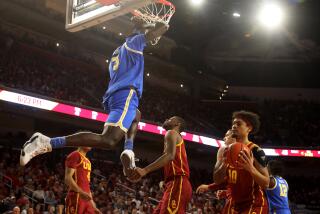That âSuper-Cripâ Casts a Long Shadow
The front pages and sports pages were filled with the performance of Mark Wellman on El Capitan last week. The headline in the Los Angeles Times declared âParaplegic Gets to Top in 8-Day Yosemite Climb.â This 29-year-old park ranger, made a paraplegic in a fall seven years before, had inspired a nation and much of the world by his brave actions. He had done the equivalent of 7,000 push-ups to reach the top by flexing his massive biceps.
The AP color picture that appeared in newspapers showed Mike Corbett, his companion and an expert climber himself, carrying Wellman the last 100 yards.
Two days earlier, a small wire-service report was carried by some newspapers; in The Times, it was headlined: âOrder Aiding Handicapped on Buses Upset.â These few words told more about the real-life struggle of the mass of people with disabilities than any orgy of media attention to a single âsuper-crip.â
Only a few months ago, a three-judge panel of the U.S. 3rd Circuit Court of Appeals found that the Department of Transportation had been violating the handicapped access law in its regulations. The effect has been to prevent access by the handicapped to at least two-thirds of public transportation across the country. Now a panel of 12 judges, called together to review the circuit courtâs decision, had ruled that it overstepped the boundaries of the lawsuit.
Why the review? The Bush Administration Department of Justice had called for it. Disabled people all across America were outraged. In his speech accepting his partyâs nomination last summer, George Bush had declared his commitment to bringing people with disabilities into the mainstream. Many disabled people, used to being ignored, voted for him in appreciation of this single reference.
A paraplegic friend of mine may have summed up the reality. Before his injury, my friend was a prosperous owner of a small metal-working business. He was now unemployed and living in government-subsidized housing in Connecticut. As we watched Bushâs speech together, my friend remarked that moving people into the mainstream probably meant removing provisions to meet their special needs. We disabled would have to sink or swim on our own. Our freedom would be maximized while our ability to survive was minimized.
Once in office, the Bush Administration rejected government funding for wheelchair lifts for buses. The expense would be about 5% of the cost of a new bus. If all buses in Los Angeles were so equipped, the maintenance costs would be about 1% of the bus systemâs operating budget--less than what air conditioning costs.
My first response to the color picture of Mark Wellman being piggy-backed to the top of El Capitan was fury and hate. Hate for people whose pursuit of personal fantasies hurts the struggle for equal rights of the great mass of physically handicapped persons down here in the everyday world. Hate for the media whose able-bodied mentality glorifies the very physical abilities that most of the physically disabled lack. Hate for those who will use the physical accomplishments of a Mark Wellman as a rationale to oppose physical modifications of transit, streets, buildings and workplaces. Hate for members of the press who, year in and year out, rewrite the same âinspirational super-cripâ story and believe that they are helping the disabled.
As I looked at the picture of Wellman being piggy-backed up the final distance to the top, a 50-year-old memory popped into my consciousness. The picture was of a little boy waiting in front of his house in Jersey City for the arrival of the school bus for the handicapped. His mother had dressed him warmly, carefully covering the leather straps and cold steel braces that extended from the bottom of his feet to under his arms. She propped him up on the sidewalk. To a passing driver, he looked like any other chubby-faced 8-year-old. His mother liked him to look ânormal.â
And then the Yellow Coach would arrive. A wiry little man would hop down the steps, sling the little boy over his back like a bag of coal and dump him into a seat. He would be hauled out of sight to a special school where he would receive a special inferior education. Schooling would end at the eighth grade for those who had not found a way to climb stairs.
That âcrippled kidâ was me. And a lot of that âspecial,â segregated and inferior help ended up hurting me a great deal when I got the exceedingly strange idea that I wanted to complete high school and go on to college.
Looking at the fuss about a âclimberâ who got to the top of a mountain with the use of a special steel appliance, special leg coverings, special hooks and ropes put in place for him and, finally, a special piggy-back by an older man to the top, I couldnât help but think how little has changed.
Our mainstream will continue to be the societal runoff trickling down the American gutter. When the TV cameras are off and reporters have gone looking for the next super-crip, when the damage done to Wellmanâs celebrated shoulders begins to show in immobility and pain, even he has a good chance of joining other disabled persons in our special kind of mainstream.
More to Read
Sign up for Essential California
The most important California stories and recommendations in your inbox every morning.
You may occasionally receive promotional content from the Los Angeles Times.










